Grief Theories: An Analysis of Psychological Perspectives
VerifiedAdded on 2023/04/26
|5
|1027
|489
Essay
AI Summary
This essay delves into five prominent theories of grief, providing a comprehensive overview of how individuals and families navigate the challenging experience of bereavement. The paper begins by examining John Bowlby's attachment theory, which frames grief as a fundamental human response to the loss of significant relationships. It then explores William Worden's task-based approach, highlighting the active processes involved in adjusting to loss. The dual process model by Stroebe and Schut is discussed, emphasizing the dynamic oscillation between loss-oriented and restoration-oriented coping strategies. The essay also examines the continuing bonds theory by Klass, which challenges traditional views by suggesting the importance of maintaining a connection with the deceased. Finally, the paper addresses family systems theory, underscoring the impact of grief on family dynamics and the reorganization of roles. The essay provides a nuanced understanding of grief, drawing on various psychological perspectives to offer insights into the complexities of coping with loss.
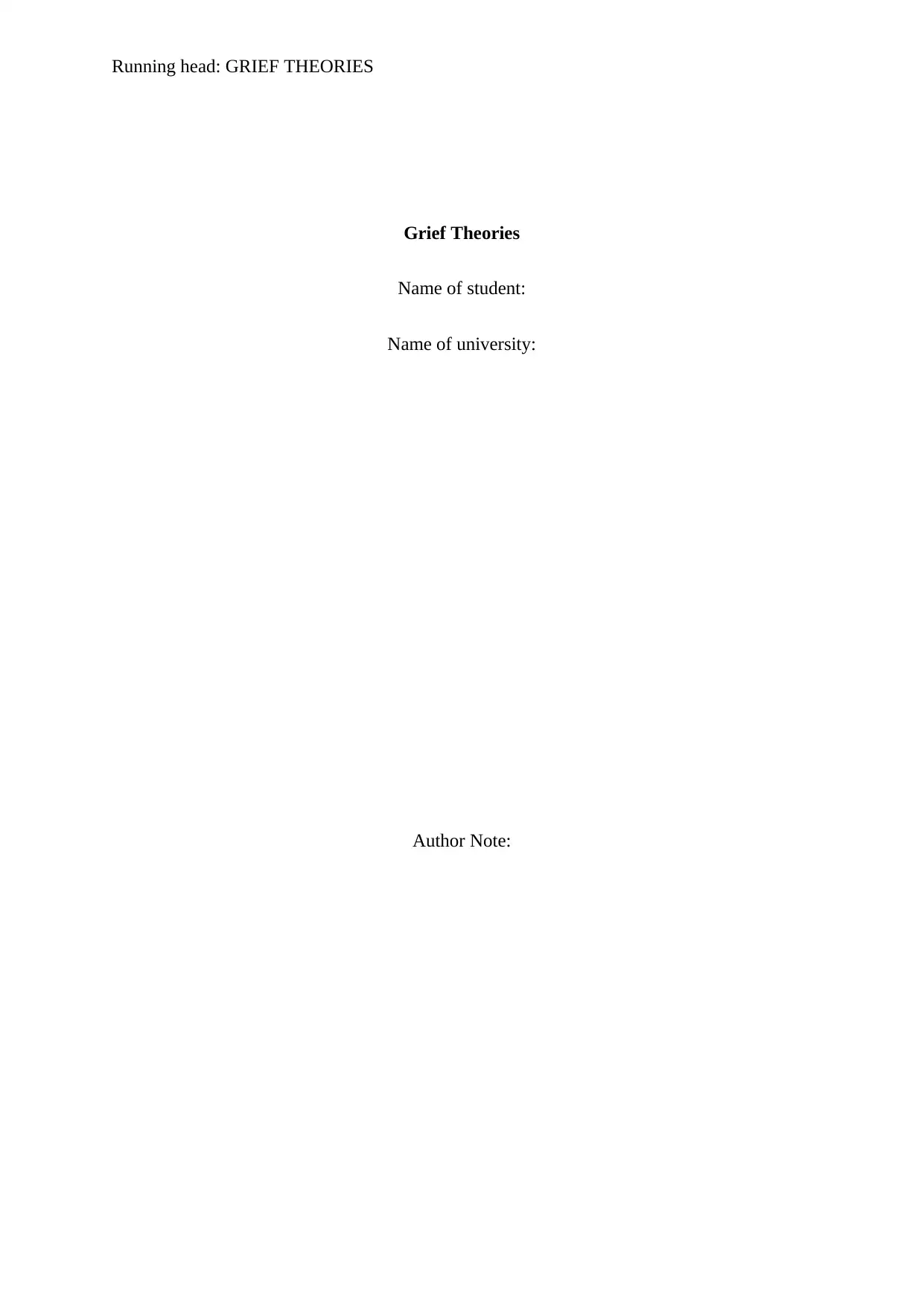
Running head: GRIEF THEORIES
Grief Theories
Name of student:
Name of university:
Author Note:
Grief Theories
Name of student:
Name of university:
Author Note:
Paraphrase This Document
Need a fresh take? Get an instant paraphrase of this document with our AI Paraphraser
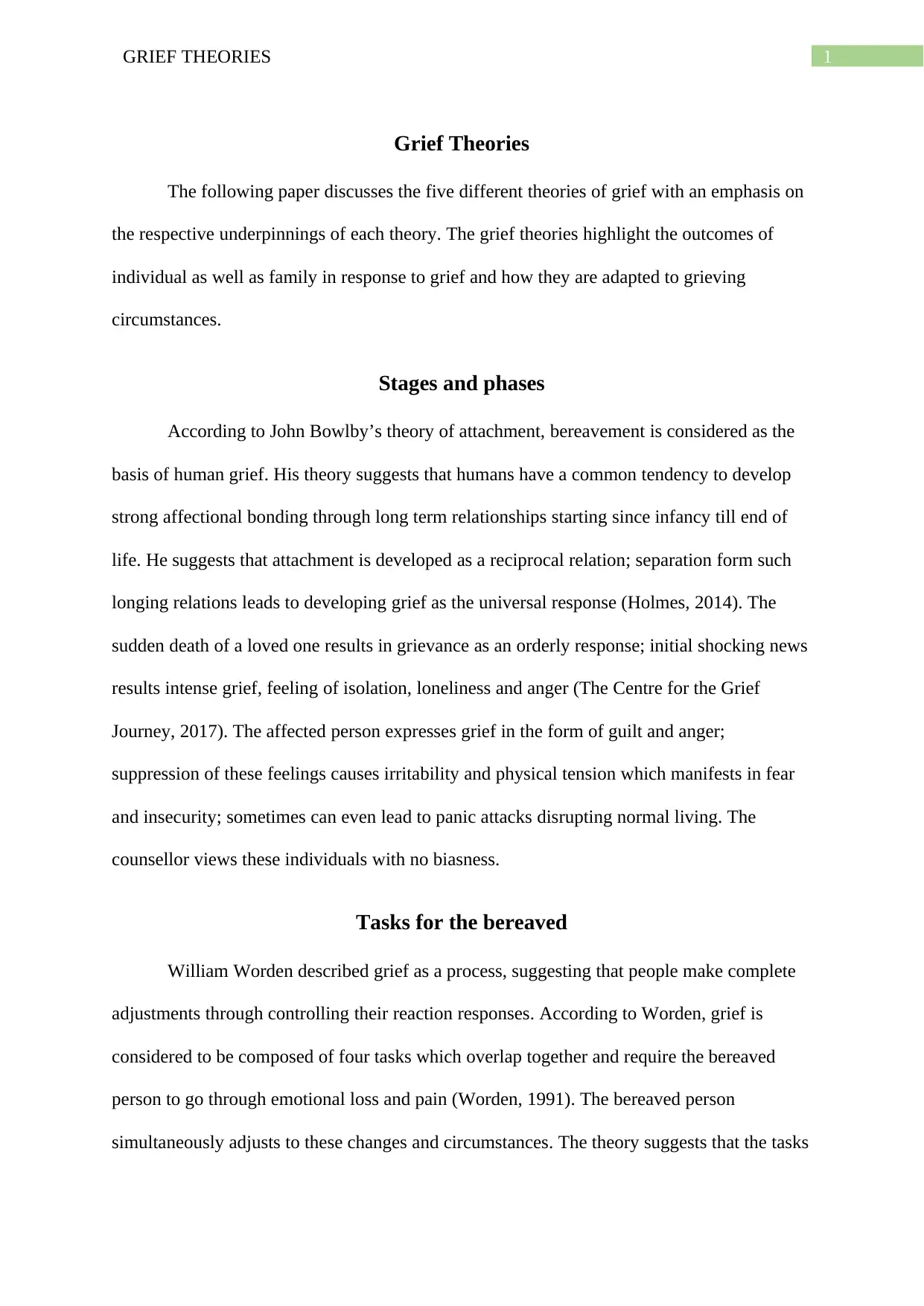
1GRIEF THEORIES
Grief Theories
The following paper discusses the five different theories of grief with an emphasis on
the respective underpinnings of each theory. The grief theories highlight the outcomes of
individual as well as family in response to grief and how they are adapted to grieving
circumstances.
Stages and phases
According to John Bowlby’s theory of attachment, bereavement is considered as the
basis of human grief. His theory suggests that humans have a common tendency to develop
strong affectional bonding through long term relationships starting since infancy till end of
life. He suggests that attachment is developed as a reciprocal relation; separation form such
longing relations leads to developing grief as the universal response (Holmes, 2014). The
sudden death of a loved one results in grievance as an orderly response; initial shocking news
results intense grief, feeling of isolation, loneliness and anger (The Centre for the Grief
Journey, 2017). The affected person expresses grief in the form of guilt and anger;
suppression of these feelings causes irritability and physical tension which manifests in fear
and insecurity; sometimes can even lead to panic attacks disrupting normal living. The
counsellor views these individuals with no biasness.
Tasks for the bereaved
William Worden described grief as a process, suggesting that people make complete
adjustments through controlling their reaction responses. According to Worden, grief is
considered to be composed of four tasks which overlap together and require the bereaved
person to go through emotional loss and pain (Worden, 1991). The bereaved person
simultaneously adjusts to these changes and circumstances. The theory suggests that the tasks
Grief Theories
The following paper discusses the five different theories of grief with an emphasis on
the respective underpinnings of each theory. The grief theories highlight the outcomes of
individual as well as family in response to grief and how they are adapted to grieving
circumstances.
Stages and phases
According to John Bowlby’s theory of attachment, bereavement is considered as the
basis of human grief. His theory suggests that humans have a common tendency to develop
strong affectional bonding through long term relationships starting since infancy till end of
life. He suggests that attachment is developed as a reciprocal relation; separation form such
longing relations leads to developing grief as the universal response (Holmes, 2014). The
sudden death of a loved one results in grievance as an orderly response; initial shocking news
results intense grief, feeling of isolation, loneliness and anger (The Centre for the Grief
Journey, 2017). The affected person expresses grief in the form of guilt and anger;
suppression of these feelings causes irritability and physical tension which manifests in fear
and insecurity; sometimes can even lead to panic attacks disrupting normal living. The
counsellor views these individuals with no biasness.
Tasks for the bereaved
William Worden described grief as a process, suggesting that people make complete
adjustments through controlling their reaction responses. According to Worden, grief is
considered to be composed of four tasks which overlap together and require the bereaved
person to go through emotional loss and pain (Worden, 1991). The bereaved person
simultaneously adjusts to these changes and circumstances. The theory suggests that the tasks
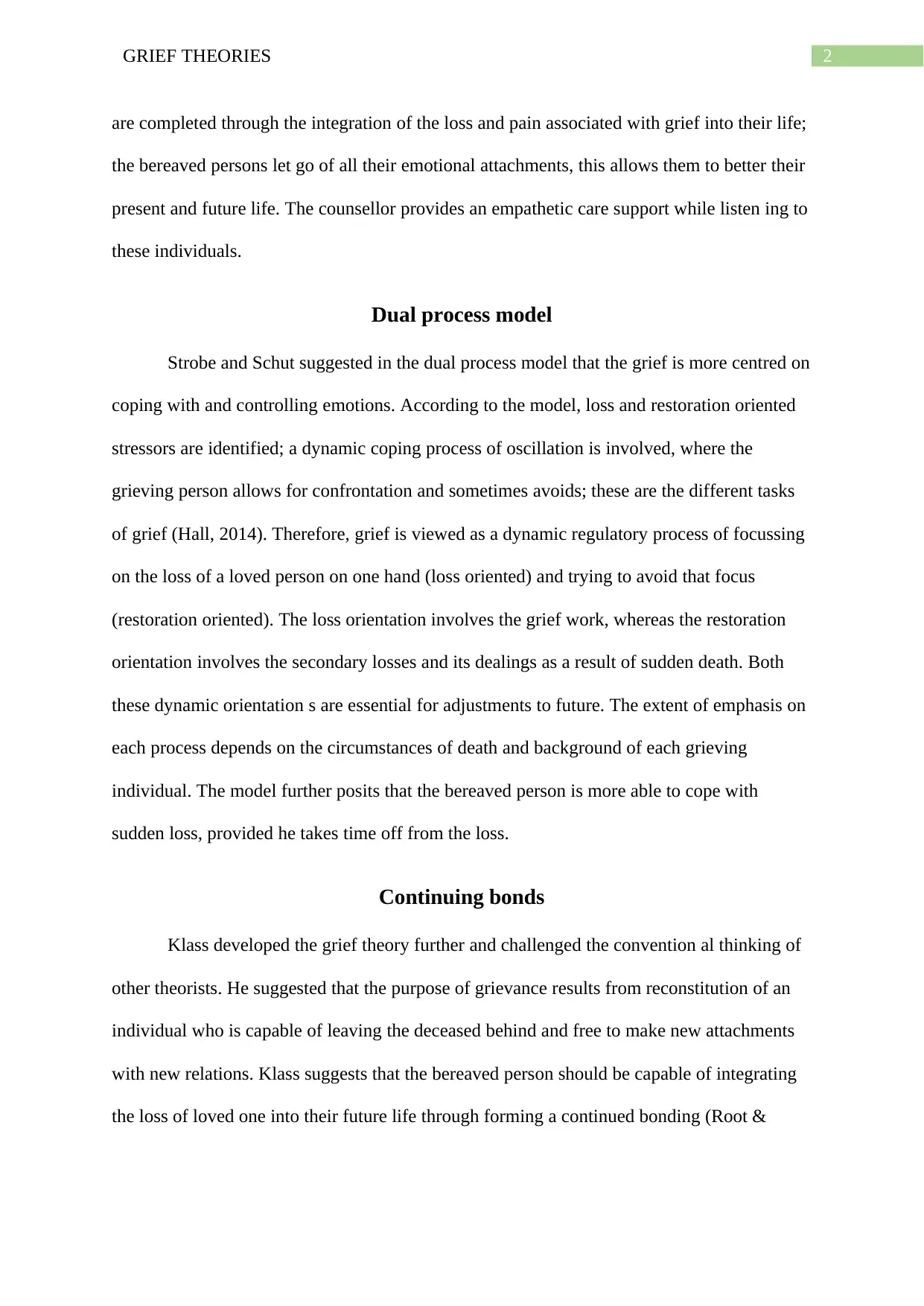
2GRIEF THEORIES
are completed through the integration of the loss and pain associated with grief into their life;
the bereaved persons let go of all their emotional attachments, this allows them to better their
present and future life. The counsellor provides an empathetic care support while listen ing to
these individuals.
Dual process model
Strobe and Schut suggested in the dual process model that the grief is more centred on
coping with and controlling emotions. According to the model, loss and restoration oriented
stressors are identified; a dynamic coping process of oscillation is involved, where the
grieving person allows for confrontation and sometimes avoids; these are the different tasks
of grief (Hall, 2014). Therefore, grief is viewed as a dynamic regulatory process of focussing
on the loss of a loved person on one hand (loss oriented) and trying to avoid that focus
(restoration oriented). The loss orientation involves the grief work, whereas the restoration
orientation involves the secondary losses and its dealings as a result of sudden death. Both
these dynamic orientation s are essential for adjustments to future. The extent of emphasis on
each process depends on the circumstances of death and background of each grieving
individual. The model further posits that the bereaved person is more able to cope with
sudden loss, provided he takes time off from the loss.
Continuing bonds
Klass developed the grief theory further and challenged the convention al thinking of
other theorists. He suggested that the purpose of grievance results from reconstitution of an
individual who is capable of leaving the deceased behind and free to make new attachments
with new relations. Klass suggests that the bereaved person should be capable of integrating
the loss of loved one into their future life through forming a continued bonding (Root &
are completed through the integration of the loss and pain associated with grief into their life;
the bereaved persons let go of all their emotional attachments, this allows them to better their
present and future life. The counsellor provides an empathetic care support while listen ing to
these individuals.
Dual process model
Strobe and Schut suggested in the dual process model that the grief is more centred on
coping with and controlling emotions. According to the model, loss and restoration oriented
stressors are identified; a dynamic coping process of oscillation is involved, where the
grieving person allows for confrontation and sometimes avoids; these are the different tasks
of grief (Hall, 2014). Therefore, grief is viewed as a dynamic regulatory process of focussing
on the loss of a loved person on one hand (loss oriented) and trying to avoid that focus
(restoration oriented). The loss orientation involves the grief work, whereas the restoration
orientation involves the secondary losses and its dealings as a result of sudden death. Both
these dynamic orientation s are essential for adjustments to future. The extent of emphasis on
each process depends on the circumstances of death and background of each grieving
individual. The model further posits that the bereaved person is more able to cope with
sudden loss, provided he takes time off from the loss.
Continuing bonds
Klass developed the grief theory further and challenged the convention al thinking of
other theorists. He suggested that the purpose of grievance results from reconstitution of an
individual who is capable of leaving the deceased behind and free to make new attachments
with new relations. Klass suggests that the bereaved person should be capable of integrating
the loss of loved one into their future life through forming a continued bonding (Root &
⊘ This is a preview!⊘
Do you want full access?
Subscribe today to unlock all pages.

Trusted by 1+ million students worldwide
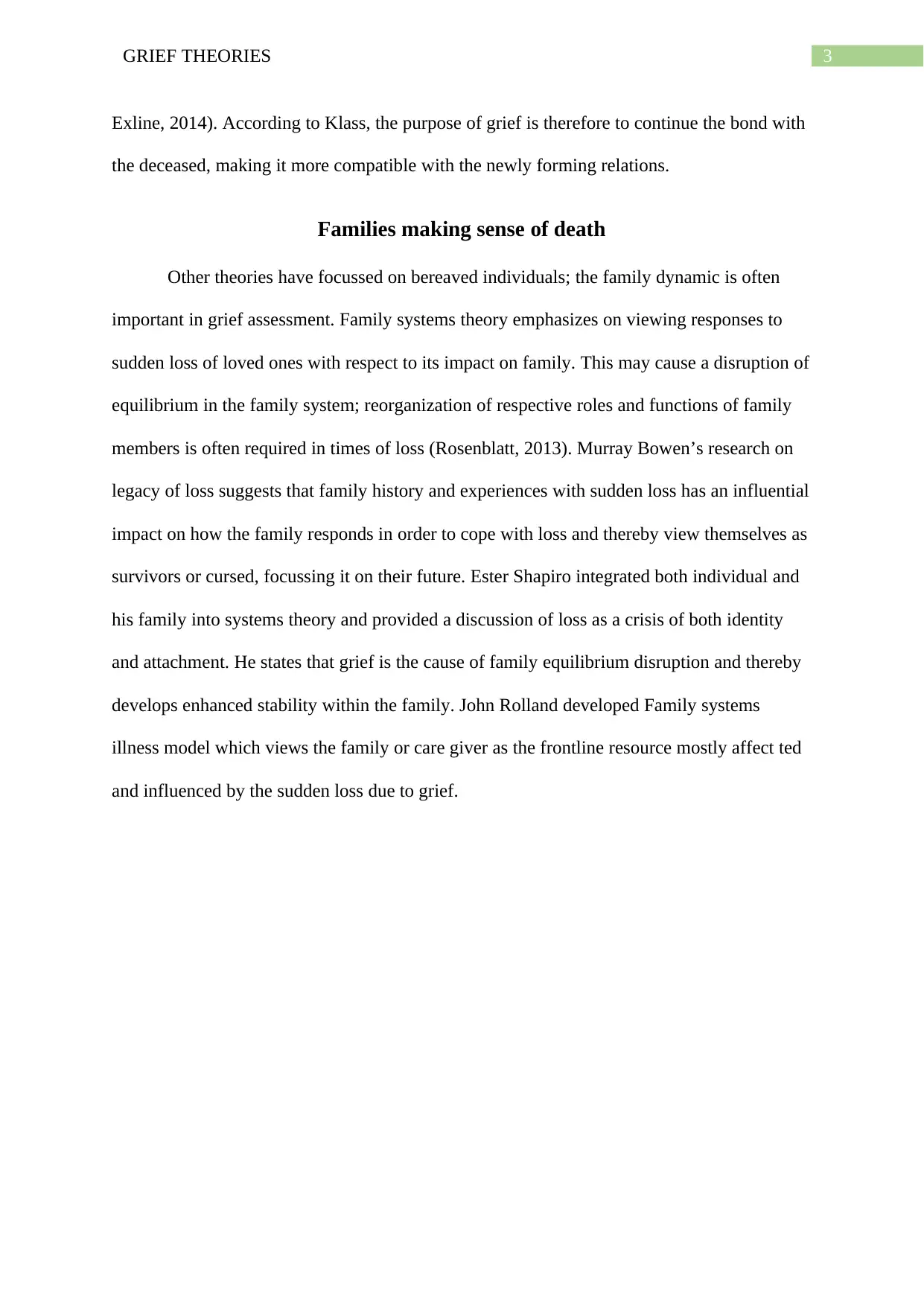
3GRIEF THEORIES
Exline, 2014). According to Klass, the purpose of grief is therefore to continue the bond with
the deceased, making it more compatible with the newly forming relations.
Families making sense of death
Other theories have focussed on bereaved individuals; the family dynamic is often
important in grief assessment. Family systems theory emphasizes on viewing responses to
sudden loss of loved ones with respect to its impact on family. This may cause a disruption of
equilibrium in the family system; reorganization of respective roles and functions of family
members is often required in times of loss (Rosenblatt, 2013). Murray Bowen’s research on
legacy of loss suggests that family history and experiences with sudden loss has an influential
impact on how the family responds in order to cope with loss and thereby view themselves as
survivors or cursed, focussing it on their future. Ester Shapiro integrated both individual and
his family into systems theory and provided a discussion of loss as a crisis of both identity
and attachment. He states that grief is the cause of family equilibrium disruption and thereby
develops enhanced stability within the family. John Rolland developed Family systems
illness model which views the family or care giver as the frontline resource mostly affect ted
and influenced by the sudden loss due to grief.
Exline, 2014). According to Klass, the purpose of grief is therefore to continue the bond with
the deceased, making it more compatible with the newly forming relations.
Families making sense of death
Other theories have focussed on bereaved individuals; the family dynamic is often
important in grief assessment. Family systems theory emphasizes on viewing responses to
sudden loss of loved ones with respect to its impact on family. This may cause a disruption of
equilibrium in the family system; reorganization of respective roles and functions of family
members is often required in times of loss (Rosenblatt, 2013). Murray Bowen’s research on
legacy of loss suggests that family history and experiences with sudden loss has an influential
impact on how the family responds in order to cope with loss and thereby view themselves as
survivors or cursed, focussing it on their future. Ester Shapiro integrated both individual and
his family into systems theory and provided a discussion of loss as a crisis of both identity
and attachment. He states that grief is the cause of family equilibrium disruption and thereby
develops enhanced stability within the family. John Rolland developed Family systems
illness model which views the family or care giver as the frontline resource mostly affect ted
and influenced by the sudden loss due to grief.
Paraphrase This Document
Need a fresh take? Get an instant paraphrase of this document with our AI Paraphraser
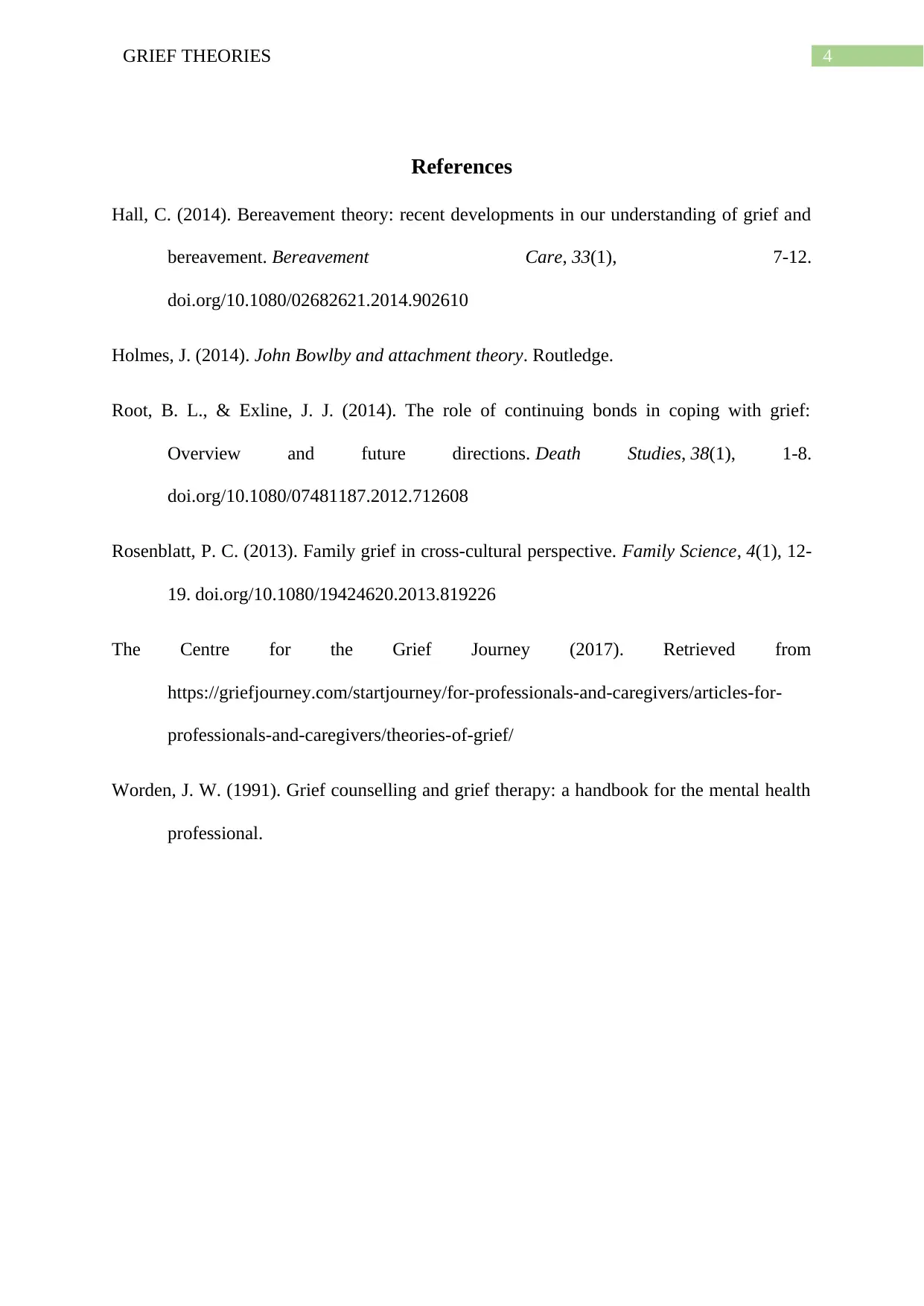
4GRIEF THEORIES
References
Hall, C. (2014). Bereavement theory: recent developments in our understanding of grief and
bereavement. Bereavement Care, 33(1), 7-12.
doi.org/10.1080/02682621.2014.902610
Holmes, J. (2014). John Bowlby and attachment theory. Routledge.
Root, B. L., & Exline, J. J. (2014). The role of continuing bonds in coping with grief:
Overview and future directions. Death Studies, 38(1), 1-8.
doi.org/10.1080/07481187.2012.712608
Rosenblatt, P. C. (2013). Family grief in cross-cultural perspective. Family Science, 4(1), 12-
19. doi.org/10.1080/19424620.2013.819226
The Centre for the Grief Journey (2017). Retrieved from
https://griefjourney.com/startjourney/for-professionals-and-caregivers/articles-for-
professionals-and-caregivers/theories-of-grief/
Worden, J. W. (1991). Grief counselling and grief therapy: a handbook for the mental health
professional.
References
Hall, C. (2014). Bereavement theory: recent developments in our understanding of grief and
bereavement. Bereavement Care, 33(1), 7-12.
doi.org/10.1080/02682621.2014.902610
Holmes, J. (2014). John Bowlby and attachment theory. Routledge.
Root, B. L., & Exline, J. J. (2014). The role of continuing bonds in coping with grief:
Overview and future directions. Death Studies, 38(1), 1-8.
doi.org/10.1080/07481187.2012.712608
Rosenblatt, P. C. (2013). Family grief in cross-cultural perspective. Family Science, 4(1), 12-
19. doi.org/10.1080/19424620.2013.819226
The Centre for the Grief Journey (2017). Retrieved from
https://griefjourney.com/startjourney/for-professionals-and-caregivers/articles-for-
professionals-and-caregivers/theories-of-grief/
Worden, J. W. (1991). Grief counselling and grief therapy: a handbook for the mental health
professional.
1 out of 5
Related Documents
Your All-in-One AI-Powered Toolkit for Academic Success.
+13062052269
info@desklib.com
Available 24*7 on WhatsApp / Email
![[object Object]](/_next/static/media/star-bottom.7253800d.svg)
Unlock your academic potential
Copyright © 2020–2025 A2Z Services. All Rights Reserved. Developed and managed by ZUCOL.





